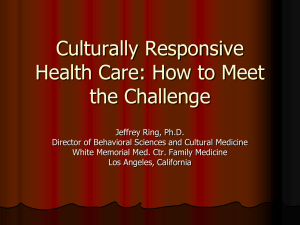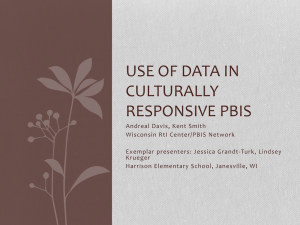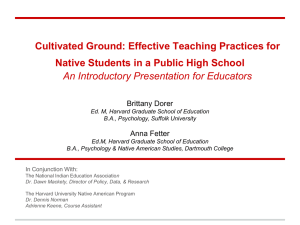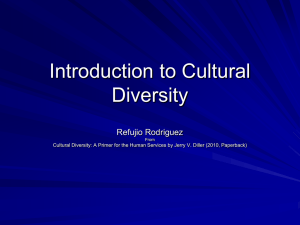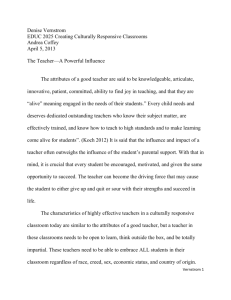Culturally
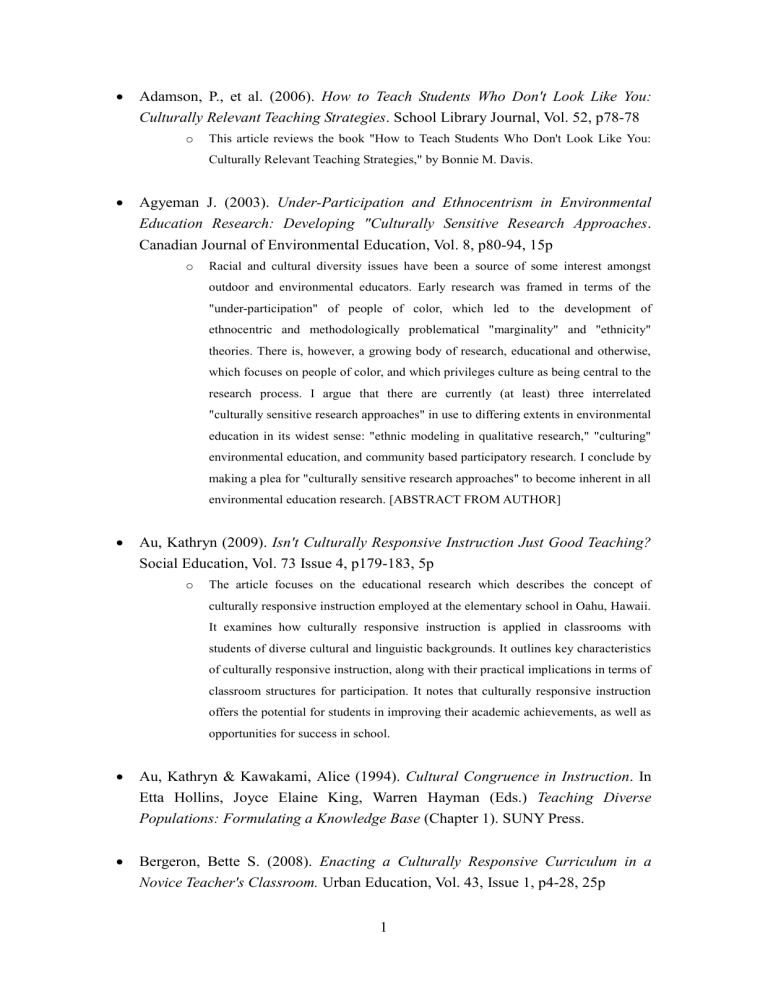
Adamson, P., et al. (2006). How to Teach Students Who Don't Look Like You:
Culturally Relevant Teaching Strategies . School Library Journal, Vol. 52, p78-78 o
This article reviews the book "How to Teach Students Who Don't Look Like You:
Culturally Relevant Teaching Strategies," by Bonnie M. Davis.
Agyeman J. (2003). Under-Participation and Ethnocentrism in Environmental
Education Research: Developing "Culturally Sensitive Research Approaches .
Canadian Journal of Environmental Education, Vol. 8, p80-94, 15p o
Racial and cultural diversity issues have been a source of some interest amongst outdoor and environmental educators. Early research was framed in terms of the
"under-participation" of people of color, which led to the development of ethnocentric and methodologically problematical "marginality" and "ethnicity" theories. There is, however, a growing body of research, educational and otherwise, which focuses on people of color, and which privileges culture as being central to the research process. I argue that there are currently (at least) three interrelated
"culturally sensitive research approaches" in use to differing extents in environmental education in its widest sense: "ethnic modeling in qualitative research," "culturing" environmental education, and community based participatory research. I conclude by making a plea for "culturally sensitive research approaches" to become inherent in all environmental education research. [ABSTRACT FROM AUTHOR]
Au, Kathryn (2009).
Isn't Culturally Responsive Instruction Just Good Teaching?
Social Education, Vol. 73 Issue 4, p179-183, 5p o
The article focuses on the educational research which describes the concept of culturally responsive instruction employed at the elementary school in Oahu, Hawaii.
It examines how culturally responsive instruction is applied in classrooms with students of diverse cultural and linguistic backgrounds. It outlines key characteristics of culturally responsive instruction, along with their practical implications in terms of classroom structures for participation. It notes that culturally responsive instruction offers the potential for students in improving their academic achievements, as well as opportunities for success in school.
Au, Kathryn & Kawakami, Alice (1994). Cultural Congruence in Instruction . In
Etta Hollins, Joyce Elaine King, Warren Hayman (Eds.) Teaching Diverse
Populations: Formulating a Knowledge Base (Chapter 1). SUNY Press.
Bergeron, Bette S. (2008). Enacting a Culturally Responsive Curriculum in a
Novice Teacher's Classroom.
Urban Education, Vol. 43, Issue 1, p4-28, 25p
1
o
Many educators suggest that novice teachers lack the preparation necessary to be successful in today's urban classrooms, particularly when the experiences of those novices are vastly different from their students. However, it can also be suggested that culturally responsive practices have the potential to counteract the "cultural disequilibrium" that many novices encounter. In this narrative case study, the author traces one novice teacher's journey within a diverse, urban classroom. Data from this study suggest that a novice teacher's support systems, administrator, professional development, and the capacity to take risks contribute to his or her effectiveness in the classroom. Implications for teacher educators include providing instructional and experiential modeling of culturally responsive practices, informing pre-service teachers of current educational policies and strategies for becoming student advocates, and becoming engaged within schools to support the implementation of induction programs that authentically prepare novices to turn cultural "disequilibrium" into cultural responsivity. [ABSTRACT FROM AUTHOR]
Bergstrom, A. & Peacock, Thomas D. (2005). Culturally Responsive Teaching for
American Indian Students . Tribal College Journal, Vol. 16 Issue 3, p57-57, 1/3p o
Reviews the book "Culturally Responsive Teaching for American Indian Students", by Cornel Pewewardy and Patricia Cahape Hammer.
Bonnie M. Davis (2005).
How To Teach Students Who Don’t Look Like You:
Culturally Relevant Teaching Strategies . Corwin Press.
Brown, Monica R. (2007). Educating All Students: Creating Culturally
Responsive Teachers, Classrooms, and Schools . Intervention in School & Clinic,
Vol. 43 Issue 1, p57-62, 6p o
The author discusses the increase of students from culturally and linguistically diverse (CLD) backgrounds and education in the U.S. The author reports that teachers are attempting to develop a relationship between students' cultures and the school culture, a method that is known as culturally responsive teaching (CLT). The author provides examples of areas in which CLT teachers should be trained and identifies characteristics that are thought to be necessary for an effective CLT teacher.
The author also discusses elements of a culturally responsive classroom, offers examples of culturally responsive classroom activities, and discusses the need to make an entire school a culturally responsive environment.
2
Davis, R. D., Ramahlo, T., Beyerbach, B., & London, A. (2008). A Culturally
Relevant Teaching Course: Reflecting Pre-service Teachers' Thinking . Teaching
Education, Vol. 19, Number 3, p223-234, 12p o
This article seeks to expand pre-service teachers' understanding of cultures through critical examination of personal cultural backgrounds, as well as, of those diverse groups who historically have experienced oppression in US society and its educational system. The authors share the story of how they develop and implement the course, setting it in the context of our teaching for a social justice-oriented teacher education program in a predominantly White, rural, state university college.
The authors indicate the literature from which we developed the course content and its activities; we analyze pre-service teachers' awareness of their cultural identities; and, describe the implications of this knowledge for teaching as reflected in the cultural autobiographies and narratives pre-service students write at the beginning and end of the course. The authors hope this study will be helpful to other multicultural educators implementing similar courses.
Gail Weinstein (1999)
Learners’ Lives as Curriculum: Six Journeys to Immigrant
Literacy . Delta Systems Co., Inc.
Gay, Geneva (2000). Culturally Responsive Teaching: Theory, Research, and
Practice. Multicultural Education Series. ISBN: 0-8077-3954-5 o
This volume makes the case for using culturally responsive teaching to improve the school performance of underachieving students of color. Key components of culturally responsive teaching are discussed. The chapters are: (1) "Challenges and
Perspectives"; (2) "Power Pedagogy through Cultural Responsiveness"; (3) "The
Power of Caring"; (4) "Culture and Communication in the Classroom"; (5) "Ethnic and Cultural Diversity in Curriculum Content"; (6) "Cultural Congruity in Teaching and Learning"; (7) "Culturally Responsive Pedagogical Praxis: A Personal Case"; and
(8) "Epilogue: Moving Forth." (Contains multiple references.) (SLD)
Howard, Tyrone C.(2001). Telling Their Side of the Story: African-American
Students' Perceptions of Culturally Relevant Teaching . Urban Review, Vol. 33
Issue 2, p131, 19p o
An increasing amount of scholarship has documented the salience of culturally relevant teaching practices for ethnically and linguistically diverse students. However, research examining these students' perceptions and interpretations of these learning environments has been minimal at best. In this article, the author details the findings from a study that sought to assess African-American elementary students'
3
interpretations of culturally relevant teachers within urban contexts. Student responses indicated that culturally relevant teaching strategies had a positive affect on student effort and engagement in class content and were consistent with the theoretical principles of culturally relevant pedagogy. The qualitative data revealed three key findings that students preferred in their learning environments (1) teachers who displayed caring bonds and attitudes toward them, (2) teachers who established community- and family-type classroom environments, and (3) teachers who made learning an entertaining and fun process. [ABSTRACT FROM AUTHOR]
Kress, Helen M. (2004). Educating Culturally Responsive Teachers: A Coherent
Approach . Journal of Negro Education, Vol. 73 Issue 4, p461-462, 2p o
Reviews the book "Educating Culturally Responsive Teachers: A Coherent
Approach," by Ana Maria Villegas and Tamara Lucas.
Ladson-Billings, G. (2001). Crossing Over to Canaan: The Journey of New
Teachers in Diverse Classrooms. Jossey-Bass
Ladson-Billings, G. (1992). Reading Between the Lines and Beyond the Pages: A
Culturally Relevant Approach to Literacy Teaching.
Theory Into Practice, Vol. 31,
Issue 4, p312, 9p o
Highlights a pedagogical approach to the literacy education of minority students in the United States that transcend the theoretical and practical challenges. Presentation of two cases to illustrate the approach; Changes in the literacy debate; Goal of culturally relevant teaching to produce critically minded and politically active citizens; Acquisition of a variety of literacies in the process of achieving the goal.
Villegas, Maria & Lucas, Tamara (2002). Educating Culturally Responsive
Teachers: A Coherent Approach . SUNY Series, Teacher Preparation and
Development. ISBN: 0-7914-5240-9 o
This book examines what is needed to accomplish the task of staffing U.S. schools with culturally responsive teachers, discussing the specific elements of teacher education programs needed for the country's diverse public schools. The book focuses on the importance of recruiting and preparing a diverse teaching force, proposing a vision for restructuring the teacher education curriculum, reconceiving the pedagogy used to prepare prospective teachers, and transforming the institutional context in order to support the recommended curricular and pedagogical changes. It explains that the typical response of adding a course or two on multicultural education without altering the established teacher education curriculum cannot meet
4
the goal of culturally responsive teaching. Five chapters focus on: (1) "The Shifting
Demographic Landscape"; (2) "Developing Fundamental Orientations for Teaching a
Hanging Student Population"; (3) "Fostering Culturally Responsive Teaching"; (4)
"Modeling the Practice of Culturally Responsive Teaching"; and (5) "The
Institutional Context Needed To Educate Culturally Responsive Teachers." The book includes exemplary practices that offer guidance for educators in their work of restructuring teacher education for diversity. (Contains approximately 600 references.)
(SM)
Luis C. Moll, Nonna González & Cathy Amanti (Eds.) (2005) Funds o f
Knowledge: Theorizing Practices in Households, Communities and Classrooms.
Lawrence Erlbaum Associates.
Irizarry, Jason G. (2007). Part I: Advancing the Conversation: Ethnic and Urban
Intersections in the Classroom: Latino Students, Hybrid Identities, and Culturally
Responsive Pedagogy.
Multicultural Perspectives, Vol. 9 Issue 3, p21-28, 8p o
Drawing from data collected through classroom observations and in-depth interviews, this article describes and analyzes practices identified as culturally responsive by
Latinos students in an urban, multiethnic/racial context. The findings suggest that culturally responsive pedagogy must be more broadly conceptualized to address the cultural identities of students who have complex identities because of their experiences with peers of many varied identities, those whose urban roots have resulted in hybrid identities, and those who are multiethnic/multiracial. Based on these findings, the article forwards the concept of "cultural connectedness" as a framework for practicing a non-essentializing, dynamic approach to culturally responsive pedagogy that acknowledges the hybrid nature of culture and identity.
[ABSTRACT FROM AUTHOR]
Montgomery, Winifred (2001). Creating Culturally Responsive, Inclusive
Classrooms. Teaching Exceptional Children, Vol. 33 Issue 4, p4, 6p o
Provides guidelines for creating culturally responsive, inclusive classrooms of students with culturally and linguistically diverse backgrounds. Teacher self-assessment; Use of culturally sensitive instructional methods; Establishment of a culturally friendly classroom atmosphere; Collaboration with culturally diverse families and other professionals. INSETS: Our Increasingly Diverse Classrooms;
Culturally Complex Atmosphere.
5
Neuman, Susan B & Roskos, Kathy (1994). Bridging Home and School with a
Culturally Responsive Approach . Childhood Education, Vol. 70, Issue 4, p210-214,
5p o
The authors describe the use of the culturally responsive approach to learning in bridging the fundamental discontinuity between home and school, especially for ethnic/racial minority families. The culturally responsive approach builds upon a child's own sense of identity while extending their language and literacy abilities.
The approach incorporates children's home culture, encourages collaboration between children and adults through social interaction, and shares the same standards of achievement for children from diverse backgrounds as for mainstream children.
Techniques are suggested, and case examples illustrate classroom situations.
Suggestions are made for involving parents meaningfully in curriculum, and involving parents in culturally responsive methods at home. A sampler bibliography of multiethnic literature for young children is included in the article.
Phuntsog, Nawan (2001). Culturally Responsive Teaching: What Do Selected
United States Elementary School Teachers Think?
Intercultural Education, Vol. 12
Issue 1, p51-64, 14p o
In this paper culturally responsive teaching is viewed as one way of implementing the concept of multicultural education in schools. In recent years, scholars have devoted considerable attention to the importance of aligning classroom experiences with students' home culture as a way of enhancing social, academic and cultural enrichment of all children. This study was, therefore, designed to identify perceptions of teachers toward the importance of culturally responsive teaching in elementary schools in the United States. The responses of 33 teachers were analyzed by using both qualitative and quantitative techniques. The findings of this study, along with a summary and implications for future studies, are presented in this paper. The data analysis clearly indicated that over 96% of the respondents considered culturally responsive teaching to be an important part of working with culturally diverse students. It was significant to note that the way teachers reported their perception toward the importance of culturally responsive teaching matched the manner with which they responded to the characteristics of culturally relevant teaching.
[ABSTRACT FROM AUTHOR]
Richards, Heraldo V., Brown, Ayanna E., Forde, Timothy B. (2007). Addressing
Diversity in Schools: Culturally Responsive Pedagogy.
Teaching Exceptional
Children, Vol. 39, Issue 3, p64-68, 5p o
The article presents special education briefs provided by the Council for Exceptional
6
Children (CEC) in partnership with the National Center for Culturally Responsive
Education Systems (NCCREST). Topics responded to include the need to address diversity with culturally responsive pedagogy, an explanation of culturally responsive pedagogy, and education reforms needed at an institutional level.
Roux, Johann Le (2001). Effective Schooling is Being Culturally Responsive.
Intercultural Education, Vol. 12, Issue 1, p41-50, 10p o
Instead of providing some “quick fix” prescriptive recipes to education for culturally diverse school populations, this paper would argue instead in favor of the necessity to embrace a philosophy and practice of culturally responsive education in all schools.
Effective education for cultural diversity is thus viewed in terms of successful classroom practices where all students are sensitively accommodated and thus learn successfully. Effective education is particularly directed and relevant to the specific and unique learning needs of all students. Theoretical consideration of culturally responsive schooling is relatively simple, but the practical implementation thereof often gives rise to fundamental challenges and problems. With the required empathetic understanding, knowledge and skills, which should be addressed in teacher training, teachers can make an exceptional contribution towards creating equal education opportunities for all children within a culturally diverse society. To ensure this, an accommodative, appreciative and a responsive approach to the reality of cultural diversity is of utmost importance. [ABSTRACT FROM AUTHOR]
Siwatu & Kamau Oginga (2007). Preservice Teachers’ Culturally Responsive
Teaching Self-efficacy and Outcome Expectancy Beliefs.
Teaching and Teacher
Education, Vol. 23, Number 7, p1086-1101, 16p o
Guided by the theoretical and empirical research on self-efficacy and outcome expectancy beliefs, and the Culturally Responsive Teaching Competencies [Siwatu,
K.O. (2006a). The development of the culturally responsive teaching competencies:
Implications for teacher education. Manuscript under review], two measures—the
Culturally Responsive Teaching Self-Efficacy Scale (CRTSE) and the Culturally
Responsive Teaching Outcome Expectancy (CRTOE) Scale—were developed and administered to a sample of pre-service teachers in the Midwest. The findings from this study suggest that pre-service teachers are more efficacious in their ability to help students feel like important members of the classroom and develop positive, personal relationships with their students, than they are in their ability to communicate with English Language Learners. Pre-service teachers’ culturally responsive teaching outcome expectations was highest for the possibility that a
7
positive teacher–student relationship can be established by building a sense of trust in their students. Item-specific means were lowest among the pre-service teachers for the possibility that encouraging students to use their native language will help to maintain students’ cultural identity. The implications for these findings for both research and teacher education are discussed.
Smith, Karen & Kander, Faryl (2005). Culturally Responsive Pedagogy.
Language
Arts, Vol. 83, Issue 2, p124-124, 0p o
This article presents information on the use of the terms "culturally responsive pedagogy," "culturally responsive teaching," "culturally relevant pedagogy," and
"culturally relevant teaching" that often are used interchangeably by writers. These terms share a belief that students from diverse backgrounds, like all children, need high academic expectations, positive and caring relationships with teachers, and classrooms that respect, honor, and draw on their individual, social, and cultural identities. Gloria Ladson-Billings uses the term "culturally relevant teaching" in "The
Dreamkeepers: Successful Teachers of African American Children" to define pedagogy that empowers students intellectually, socially, emotionally, and politically by using cultural referents to impart knowledge, skills, and attitudes. These cultural referents are not merely vehicles for bridging or explaining the dominant culture; they are aspects of the curriculum in their own right. Sonia Nieto defines culturally responsive education in "The Light in Their Eyes: Creating Multicultural Learning
Communities."
Villegas, A. M. (1991). Culturally Responsive Pedagogy for the 1990s and
Beyond.
Princeton, NJ: Educational Testing Service
Villegas, Maria & Lucas, Tamara (2002). Educating Culturally Responsive
Teachers: A Coherent Approach . SUNY Series, Teacher Preparation and
Development. ISBN: 0-7914-5240-9
Ware, Franita(2006). Warm Demander Pedagogy: Culturally Responsive Teaching
That Supports a Culture of Achievement for African American Students. Urban
Education, Vol. 41, Issue 4, p427-456, 30p o
This study operationalizes warm demander pedagogy as a component of culturally responsive teaching. These instructional methods emerged during a study that examined the pedagogy of two African American urban teachers as compared to the literature. Through observations and interviews, the study examined the following: (a)
How did each teacher describe her instructional practices and beliefs? (b) What
8
similarities and differences existed between the teachers' practices and beliefs? (c)
Was there evidence that the shared cultural/ethnic background of teachers and students influenced instructional practices? The study proposes warm demander and culturally responsive pedagogy to support a culture of achievement for students of color. [ABSTRACT FROM AUTHOR]
Weinstein, Carol S., Tomlinson-Clarke, Saundra& Curran, Mary(2004). Toward A
Conception of Culturally Responsive Classroom Management.
Journal of Teacher
Education, Vol. 55 Issue 1, p25-38, 14p o
Given the increasing diversity of our classrooms, a lack of multicultural competence can exacerbate the difficulties that novice teachers have with classroom management.
Definitions and expectations of appropriate behavior are culturally influenced, and conflicts are likely to occur when teachers and students come from different cultural backgrounds. The purpose of this article is to stimulate discussion of culturally responsive classroom management (CRCM). We propose a conception of CRCM that includes five essential components: (a) recognition of one's own ethnocentrism; (b) knowledge of students' cultural backgrounds; (c) understanding of the broader social, economic, and political context; (d) ability and willingness to use culturally appropriate management strategies; and (e) commitment to building caring classrooms. In the final section of the article, we suggest questions and issues for future research. [ABSTRACT FROM AUTHOR]
Howard, Tyrone C. (2003).
Culturally Relevant Pedagogy: Ingredients for Critical
Teacher Reflection.
Theory Into Practice, Vol. 42, Issue 3, p195-202, 8p o
Examines the importance of critical teacher reflection as a tool for creating culturally relevant teaching practices. Information on measures of assisting teachers translate critical reflection into culturally relevant teaching; Importance of race and culture in teaching and learning; Discussion on racial and cultural incongruence between students and teachers as a factor that explains school failure of African American,
Asian American and Latino students in the U.S.
Smith, Karen & Kander, Faryl (2005). Culturally Responsive Pedagogy.
Language
Arts, Vol. 83, Issue 2, p124-124, 1/2p
This article presents information on the use of the terms "culturally responsive pedagogy,"
"culturally responsive teaching," "culturally relevant pedagogy," and "culturally relevant teaching" that often are used interchangeably by writers. These terms share a belief that students from
9
diverse backgrounds, like all children, need high academic expectations, positive and caring relationships with teachers, and classrooms that respect, honor, and draw on their individual, social, and cultural identities. Gloria Ladson-Billings uses the term "culturally relevant teaching" in "The
Dreamkeepers: Successful Teachers of African American Children" to define pedagogy that empowers students intellectually, socially, emotionally, and politically by using cultural referents to impart knowledge, skills, and attitudes. These cultural referents are not merely vehicles for bridging or explaining the dominant culture; they are aspects of the curriculum in their own right.
Sonia Nieto defines culturally
Updated on 09/10/2009
10


